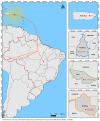Detection of a Multiple Circulation Event of Dengue Virus 2 Strains in the Northern Region of Brazil
- PMID: 38251214
- PMCID: PMC10818346
- DOI: 10.3390/tropicalmed9010017
Detection of a Multiple Circulation Event of Dengue Virus 2 Strains in the Northern Region of Brazil
Abstract
Dengue virus serotype 2 (DENV-2) is responsible for dengue epidemics on a global scale and is associated with severe cases of the disease. This study conducted a phylogenetic investigation of DENV-2 isolates from 2017 to 2021 originating from the northern states of Brazil. A total of 32 samples from DENV-2 isolates were analyzed, including 12 from Acre, 19 from Roraima, and one from Tocantins. Only one lineage of the Asian-American genotype and one lineage of the cosmopolitan genotype were observed: Lineage 1, Asian-American genotype (connection to Puerto Rico); Lineage 5, cosmopolitan genotype (connection to Peru). Our results provide important data regarding the study of DENV genotypes and lineage distribution and open up possibilities for probable introduction and dissemination routes.
Keywords: Asian-American genotype; arboviruses; cosmopolitan genotype; dengue virus serotype 2.
Conflict of interest statement
The authors declare no conflicts of interest.
Figures



References
-
- Postler T.S., Beer M., Blitvich B.J., Bukh J., de Lamballerie X., Drexler J.F., Imrie A., Kapoor A., Karganova G.G., Lemey P., et al. Renaming of the genus Flavivirus to Orthoflavivirus and extension of binomial species names within the family Flaviviridae. Arch. Virol. 2023;168:224. doi: 10.1007/s00705-023-05835-1. - DOI - PubMed
-
- World Health Organization-WHO . WHO Report on Global Surveillance of Epidemic-Prone Infectious Disease. WHO; Geneva, Switzerland: 2000. Dengue and Dengue haemorhagic fever.
LinkOut - more resources
Full Text Sources

